In Situ Experimental Investigation of Slim Curtain Wall Spandrel Integrated with Vacuum Insulation Panel
Abstract
1. Introduction
2. Materials and Methods
2.1. Specifications and in Lab Assessment of VIP Properties
2.2. Initial Numerical Computations
2.3. Outdoor Mock-Up Experimental Assessments
2.3.1. VIP Spandrel Configurations
2.3.2. Overview of Real-Scale Mockup Building Facility
2.3.3. Spandrel Fabrication, Installation, and Monitoring Systems
3. Results and Discussion
3.1. Thermal Characteristics of VIPs
3.2. Numerical Evaluations of Insulation Performance for VIP Spandrels
3.3. Thermal Performance of In Situ VIP Spandrels
3.3.1. Thermal Bridge Evaluation
3.3.2. Temperature Characteristics at Internal and External VIP/Spandrel Surfaces
3.3.3. Heat Losses/Gains
3.4. Durability of VIPs in Spandrel Cavities
3.5. Further Reflections
3.6. Limitations and Challenges
4. Conclusions and Outlook
Author Contributions
Funding
Institutional Review Board Statement
Informed Consent Statement
Data Availability Statement
Acknowledgments
Conflicts of Interest
References
- International Energy Agency (IEA). Tracking Buildings 2020. Available online: https://www.iea.org/reports/tracking-buildings-2020 (accessed on 3 March 2021).
- Smith, R.E.; Timberlake, J. Prefab Architecture: A Guide to Modular Design and Construction; John Wiley & Sons: Hoboken, NJ, USA, 2011. [Google Scholar]
- Rizzo, F.; Franco, A.; Bonati, A.; Maddaloni, G.; Caterino, N.; Occhiuzzi, A. Predictive analyses for aerodynamic investigation of curtain walls. Structures 2021, 29, 1059–1077. [Google Scholar] [CrossRef]
- Ge, H. Study on Overall Thermal Performance of Metal Curtain Walls. Ph.D. Thesis, Concordia University, Montreal, QC, Canada, 2002. [Google Scholar]
- Sanders, R.M. Curtain walls: Not just another pretty facade. J. Archit. Technol. 2006, 23, 1–8. [Google Scholar]
- Kazmierczak, K.; Hershfi, M. Review of Curtain Walls, Focusing on Design Problems and Solutions. In Proceedings of the Building Enclosure Science and Technology (BEST2) Conference, Portland, OR, USA, 15–18 April 2010. [Google Scholar]
- Bedon, C.; Amadio, C.; Noé, S. Safety issues in the seismic design of secondary frameless glass structures. Safety 2019, 5, 80. [Google Scholar] [CrossRef]
- Huang, B.; Chen, S.; Lu, W.; Mosalam, K.M. Seismic demand and experimental evaluation of the nonstructural building curtain wall: A review. Soil Dyn. Earthq. Eng. 2017, 100, 16–33. [Google Scholar] [CrossRef]
- Mojškerc, B.; Kek, T.; Grum, J. Pulse-Echo Ultrasonic Testing of Adhesively Bonded Joints in Glass Façades. Stroj. Vesn. J. Mech. Eng. 2016, 62, 147–153. [Google Scholar] [CrossRef]
- Lin, J.; Hong, X.; Ren, Z. Laser in-depth heating thermal wave detection of adhesive debonding in glass curtain walls: Numerical simulation and experiment. Measurement 2021, 177, 109268. [Google Scholar] [CrossRef]
- Teng-teng, H.; Da-Wei, Z.; Yu-xi, Z.; Jun-jin, L.; Jian-hui, L. Comprehensive appraisal of the safety of hidden frame glass curtain wall based on fuzzy theory. J. Build. Eng. 2019, 26, 100863. [Google Scholar] [CrossRef]
- Kim, T.; Kim, Y.-W.; Cho, H. A simulation-based dynamic scheduling model for curtain wall production considering construction planning reliability. J. Clean. Prod. 2021, 286, 124922. [Google Scholar] [CrossRef]
- Bedon, C.; Zhang, X.; Santos, F.; Honfi, D.; Kozłowski, M.; Arrigoni, M.; Figuli, L.; Lange, D. Performance of structural glass facades under extreme loads–Design methods, existing research, current issues and trends. Constr. Build. Mater. 2018, 163, 921–937. [Google Scholar] [CrossRef]
- Wang, Y.; Xie, Q.; Zhang, Y.; Wang, Q.; Sun, J. Sensitivity analysis of influencing factors on glass façade breakage in fire. Fire Saf. J. 2018, 98, 38–47. [Google Scholar] [CrossRef]
- Ma, X.; Tu, R.; An, W.; Xu, L.; Luo, S.; Wang, J.; Tang, F. Experimental study of interlayer effect induced by building facade curtain wall on downward flame spread behavior of polyurethane. Appl. Therm. Eng. 2020, 167, 114694. [Google Scholar] [CrossRef]
- Lam, T.; Ge, H.; Fazio, P. Impact of curtain wall configurations on building energy performance in the perimeter zone for a cold climate. Energy Procedia 2015, 78, 352–357. [Google Scholar] [CrossRef]
- Bouden, C. Influence of glass curtain walls on the building thermal energy consumption under Tunisian climatic conditions: The case of administrative buildings. Renew. Energy 2007, 32, 141–156. [Google Scholar] [CrossRef]
- Lam, T.C.A. Identifying Configurations of Plus-Energy Curtain Walls for the Perimeter Zone Using the Analysis of Variance (ANOVA) Approach. Master’s Thesis, Concordia University, Montreal, QC, Canada, 2015. [Google Scholar]
- Carbary, L.; Dunlap, A.; O’Connor, T. High performance curtain wall using vacuum insulated panels (VIP) spandrels. In Proceedings of the Glass Performance Days Conference, Tampere, Finland, 13–15 June 2013. [Google Scholar]
- Carbary, L.D.; Stanley, Y.; Nick, B. Architectural insulation modules: Thermal and structural performance for use in curtainwall construction. In Proceedings of the International Conference on Building Envelope Systems and Technologies ICBEST, Aachen, Germany, 9–12 June 2014. [Google Scholar]
- Richman, R.; Pressnail, K. A more sustainable curtain wall system: Analytical modeling of the solar dynamic buffer zone (SDBZ) curtain wall. Build. Environ. 2009, 44, 1–10. [Google Scholar] [CrossRef]
- Behr, R.A. On-site investigations of spandrel glass microenvironments. Build. Environ. 1995, 30, 61–72. [Google Scholar] [CrossRef]
- Lam, T.C.; Ge, H.; Fazio, P. Study of different glazing modelling approaches in assessing energy performance of curtain wall systems using EnergyPlus. In Proceedings of the International Building Performance Simulation Association (IBPSA) eSIM Conference, Ottawa, ON, Canada, 29 June 2014. [Google Scholar]
- Kim, G.; Lim, H.S.; Schaefer, L.; Kim, J.T. Overall environmental modelling of newly designed curtain wall facade configurations. Indoor Built Environ. 2012, 22, 168–179. [Google Scholar] [CrossRef]
- Arnesano, M.; Pandarese, G.; Martarelli, M.; Naspi, F.; Gurunatha, K.L.; Sol, C.; Portnoi, M.; Ramirez, F.V.; Parkin, I.P.; Papakonstantinou, I.; et al. Optimization of the thermochromic glazing design for curtain wall buildings based on experimental measurements and dynamic simulation. Sol. Energy 2021, 216, 14–25. [Google Scholar] [CrossRef]
- Goia, F. Search for the optimal window-to-wall ratio in office buildings in different European climates and the implications on total energy saving potential. Sol. Energy 2016, 132, 467–492. [Google Scholar] [CrossRef]
- Poirazis, H.; Blomsterberg, Å.; Wall, M. Energy simulations for glazed office buildings in Sweden. Energy Build. 2008, 40, 1161–1170. [Google Scholar] [CrossRef]
- Mainini, A.G.; Poli, T.; Zinzi, M.; Speroni, A. Metal mesh as shading devices and thermal response of an office building: Parametric analysis. Energy Procedia 2015, 78, 103–109. [Google Scholar] [CrossRef][Green Version]
- Qian, Z.-Y.; Zhao, Y.-Z.; Fu, Z.; Cao, Q.-X. Design and realization of a non-actuated glass-curtain wall-cleaning robot prototype with dual suction cups. Int. J. Adv. Manuf. Technol. 2006, 30, 147–155. [Google Scholar] [CrossRef]
- Jelle, B.P.; Hynd, A.; Gustavsen, A.; Arasteh, D.; Goudey, H.; Hart, R. Fenestration of today and tomorrow: A state-of-the-art review and future research opportunities. Sol. Energy Mater. Sol. Cells 2012, 96, 1–28. [Google Scholar] [CrossRef]
- Yu, F.; Wennersten, R.; Leng, J. A state-of-art review on concepts, criteria, methods and factors for reaching ‘thermal-daylighting balance’. Build. Environ. 2020, 186, 107330. [Google Scholar] [CrossRef]
- Cuce, E.; Riffat, S.B. A state-of-the-art review on innovative glazing technologies. Renew. Sustain. Energy Rev. 2015, 41, 695–714. [Google Scholar] [CrossRef]
- Buratti, C.; Belloni, E.; Merli, F.; Zinzi, M. Aerogel Glazing Systems for Building Applications: A Review. Energy Build. 2020, 231, 110587. [Google Scholar] [CrossRef]
- Boafo, F.E.; Kim, J.-H.; Kim, J.-T. Numerical study of slim curtain wall spandrel with integrated vacuum insulation panel: Concept, performance evaluation and challenges. Energy Build. 2019, 183, 139–150. [Google Scholar] [CrossRef]
- Postole, R.; Roppel, P.; Norris, N.; Bigdeli, K. Performance of sealed curtain wall spandrel panels that direct sunlight deep into multi-story buildings. In Proceedings of the 4th Building Enclosure Science and Technology (BEST4) Conference, Kansas City, KS, USA, 13–15 April 2015. [Google Scholar]
- Binz, A.; Moosmann, A.; Steinke, G.; Schonhardt, U.; Fregnan, F.; Simmler, H.; Brunner, S.; Ghazi, K.; Bundi, R.; Heinemann, U.; et al. HiPTI—High Performance Thermal Insulation, Annex 39 to IEA/ECBCS-Implementing Agreement. Vacuum Insulation in the Building Sector. Systems and Applications; International Energy Agency: Paris, France, 2005; Available online: https://www.iea-ebc.org/projects/project?AnnexID=39 (accessed on 26 March 2021).
- Adl-Zarrabi, B.; Quenard, D.; Johansson, P.; Heinemann, U.; Yrieix, B.; Sprengard, C.; Heinemann, U.; Mukhopadhyaya, P.; Brunner, S.; Galliano, R.; et al. Annex 65—Long Term Performance of Super-Insulating Materials in Building Components and Systems, Subtask III—Practical Applications Retrofitting at the Building Scale, Final Report; International Energy Agency: Paris, France, 2020; Available online: https://www.iea-ebc.org/projects/project?AnnexID=65 (accessed on 21 September 2020).
- Kalnæs, S.E.; Jelle, B.P. Vacuum insulation panel products: A state-of-the-art review and future research pathways. Appl. Energy 2014, 116, 355–375. [Google Scholar] [CrossRef]
- Brunner, S.; Wakili, K.G.; Stahl, T.; Binder, B. Vacuum insulation panels for building applications—Continuous challenges and developments. Energy Build. 2014, 85, 592–596. [Google Scholar] [CrossRef]
- Schiavoni, S.; Bianchi, F.; Asdrubali, F. Insulation materials for the building sector: A review and comparative analysis. Renew. Sustain. Energy Rev. 2016, 62, 988–1011. [Google Scholar] [CrossRef]
- Batard, A.; Duforestel, T.; Flandin, L.; Yrieix, B. Prediction method of the long-term thermal performance of Vacuum Insulation Panels installed in building thermal insulation applications. Energy Build. 2018, 178, 1–10. [Google Scholar] [CrossRef]
- Berardi, U.; Nikafkar, M.; Wi, S.; Kim, S. Experimental verification of the theoretical aging of vacuum insulated panels. J. Ind. Eng. Chem. 2020, 90, 300–304. [Google Scholar] [CrossRef]
- Fantucci, S.; Garbaccio, S.; Lorenzati, A.; Perino, M. Thermo-economic analysis of building energy retrofits using VIP-Vacuum Insulation Panels. Energy Build. 2019, 196, 269–279. [Google Scholar] [CrossRef]
- Baetens, R.; Jelle, B.P.; Thue, J.V.; Tenpierik, M.J.; Grynning, S.; Uvsløkk, S.; Gustavsen, A. Vacuum insulation panels for building applications: A review and beyond. Energy Build. 2010, 42, 147–172. [Google Scholar] [CrossRef]
- Gubbels, F.; Santi, D.D.; Baily, V. Durability of vacuum insulation panels in the cavity of an insulating glass unit. J. Build. Phys. 2015, 38, 485–499. [Google Scholar] [CrossRef]
- Boafo, F.E.; Kim, J.-H.; Ahn, J.-G.; Kim, S.-M.; Kim, J.-T. Slim curtain wall spandrel integrated with vacuum insulation panel: A state-of-the-art review and future opportunities. J. Build. Eng. 2021, 42, 102445. [Google Scholar] [CrossRef]
- Brunner, S.; Tharian, P.; Simmler, H.; Ghazi Wakili, K. Focused ion beam (FIB) etching to investigate aluminium-coated polymer laminates subjected to heat and moisture loads. Surf. Coat. Technol. 2008, 202, 6054–6063. [Google Scholar] [CrossRef]
- Avery Dennison Hanita Ltd. Metalized Malinated for Vacuum Insulation Panels (V08621B). Available online: https://hanita.averydennison.com/content/dam/averydennison/hanita/en/docs/home/customer-tools/vip-lam/long-very-long/pds-vip-v08621b-trilaminate.pdf (accessed on 2 October 2019).
- Kim, J.-H.; Boafo, F.E.; Kim, S.-M.; Kim, J.-T. Aging performance evaluation of vacuum insulation panel (VIP). Case Stud. Constr. Mater. 2017, 7, 329–335. [Google Scholar] [CrossRef]
- Physibel BISCO Manual. Computer Program to Calculate 2D Steady State Heat Transfer in Free-Form Objects, Version 10.0w; Physibel: Ghent, Belgium, 2012. [Google Scholar]
- Physibel TRISCO Manual. Computer Program to Calculate 3D & 2D Steady State Heat Transfer in Rectangular Objects, Version 13.0w; Physibel: Ghent, Belgium, 2015. [Google Scholar]
- Wakili, K.G.; Bundi, R.; Binder, B. Effective thermal conductivity of vacuum insulation panels. Build. Res. Inf. 2004, 32, 293–299. [Google Scholar] [CrossRef]
- Park, S.; Choi, B.-H.; Lim, J.-H.; Song, S.-Y. Evaluation of Mechanically and Adhesively Fixed External Insulation Systems Using Vacuum Insulation Panels for High-Rise Apartment Buildings. Energies 2014, 7, 5764–5786. [Google Scholar] [CrossRef]
- Isaia, F.; Fantucci, S.; Capozzoli, A.; Perino, M. Vacuum Insulation Panels: Thermal bridging effects and energy performance in real building applications. Energy Procedia 2015, 83, 269–278. [Google Scholar] [CrossRef]
- Lorenzati, A.; Fantucci, S.; Capozzoli, A.; Perino, M. The effect of different materials joint in Vacuum Insulation Panels. Energy Procedia 2014, 62, 374–381. [Google Scholar] [CrossRef]
- Lorenzati, A.; Fantucci, S.; Capozzoli, A.; Perino, M. Experimental and numerical investigation of thermal bridging effects of jointed Vacuum Insulation Panels. Energy Build. 2016, 111, 164–175. [Google Scholar] [CrossRef]
- Nussbaumer, T.; Bundi, R.; Tanner, C.; Muehlebach, H. Thermal analysis of a wooden door system with integrated vacuum insulation panels. Energy Build. 2005, 37, 1107–1113. [Google Scholar] [CrossRef]
- Tenpierik, M.; Cauberg, H. Analytical models for calculating thermal bridge effects caused by thin high barrier envelopes around vacuum insulation panels. J. Build. Phys. 2007, 30, 185–215. [Google Scholar] [CrossRef]
- Kim, S.-M.; Kim, J.-H.; Kim, J.-T. Effect of thermal bridge on the insulation performance of VIP applied walls. In Proceedings of the 6th ZEMCH International Conference, Melbourne, Australia, 29 January–5 February 2018. [Google Scholar]
- Song, J.-H.; Lim, J.-H.; Song, S.-Y. Evaluation of alternatives for reducing thermal bridges in metal panel curtain wall systems. Energy Build. 2016, 127, 138–158. [Google Scholar] [CrossRef]
- Ministry of Land, Infrastructure and Transport (MOLIT) & Korea Energy Agency (KEA). Building Energy Saving Design Guideline. Available online: https://www.energy.or.kr/web/kem_home_new/new_main.asp (accessed on 7 November 2018).
- ISO 10456:2007; Building Materials and Products—Hygrothermal Properties—Tabulated Design Values and Procedures for Determining Declared and Design Thermal Values. International Organization Standardization: Geneva, Switzerland, 2007.
- Mukhopadhyaya, P.; MacLean, D.; Korn, J.; van Reenen, D.; Molleti, S. Building application and thermal performance of vacuum insulation panels (VIPs) in Canadian subarctic climate. Energy Build. 2014, 85, 672–680. [Google Scholar] [CrossRef]
- Johansson, P.; Adl-Zarrabi, B.; Kalagasidis, A.S. Evaluation of 5 years’ performance of VIPs in a retrofitted building façade. Energy Build. 2016, 130, 488–494. [Google Scholar] [CrossRef]
- Boafo, F.E.; Chen, Z.; Li, C.; Li, B.; Xu, T. Structure of vacuum insulation panel in building system. Energy Build. 2014, 85, 644–653. [Google Scholar] [CrossRef]
- Brunner, S.; Simmler, H. In situ performance assessment of vacuum insulation panels in a flat roof construction. Vacuum 2008, 82, 700–707. [Google Scholar] [CrossRef]
- Voellinger, T.; Bassi, A.; Heitel, M. Facilitating the incorporation of VIP into precast concrete sandwich panels. Energy Build. 2014, 85, 666–671. [Google Scholar] [CrossRef]
- Molleti, S.; Mukhopadyaya, P.; Baskaran, B.; Beaulieu, P.; Sherrer, G. Application of VIPs on low sloped commercial roofing systems. In Proceedings of the 10th International Vacuum Insulation Symposium, Ottawa, ON, Canada, 15–16 September 2011. [Google Scholar]
- The 3M Company. 3M™ Sun Control Window Film Traditional Series. Available online: https://www.3m.com/3M/en_US/p/d/b00016656/ (accessed on 15 December 2021).
- ISO 10211:2007; Thermal Bridges in Building Construction—Heat Flows and Surface Temperatures—Detailed Calculations. International Organization for Standardization: Geneva, Switzerland, 2007.
- Kalamees, T. Critical values for the temperature factor to assess thermal bridges. In Proceedings of the Estonian Academy of Sciences: Engineering; Aben, H., Kurnitski, V., Eds.; Estonian Academy Publishers: Tallinn, Estonia, 2006; pp. 218–229. [Google Scholar]
- Brunner, S.; Stahl, T.; Ghazi Wakili, K. Double layered vacuum insulation panels. In Proceedings of the 3rd Building Enclosure Science and Technology (BEST3) Conference, Atlanta, GA, USA, 2–4 April 2012. [Google Scholar]
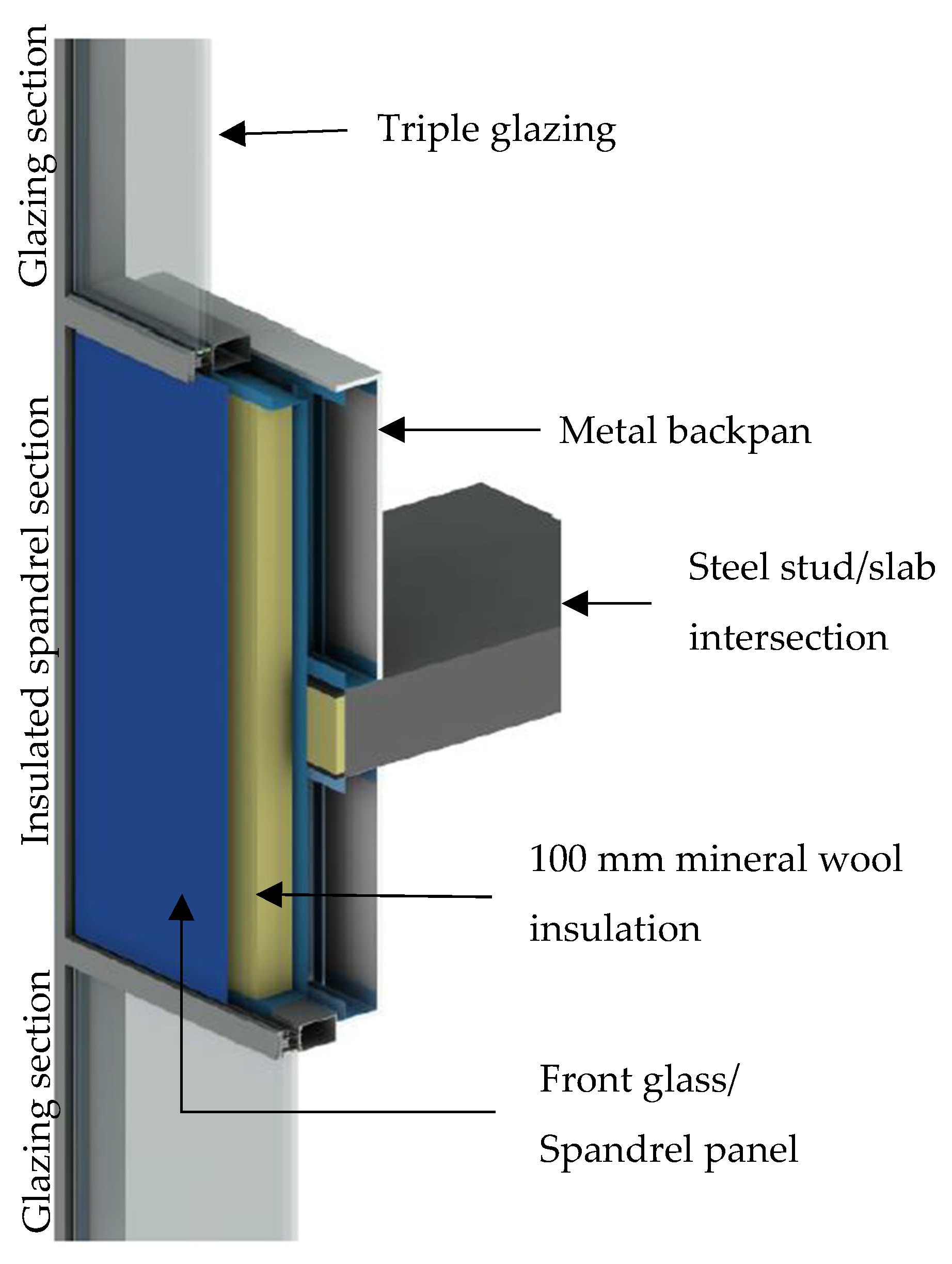
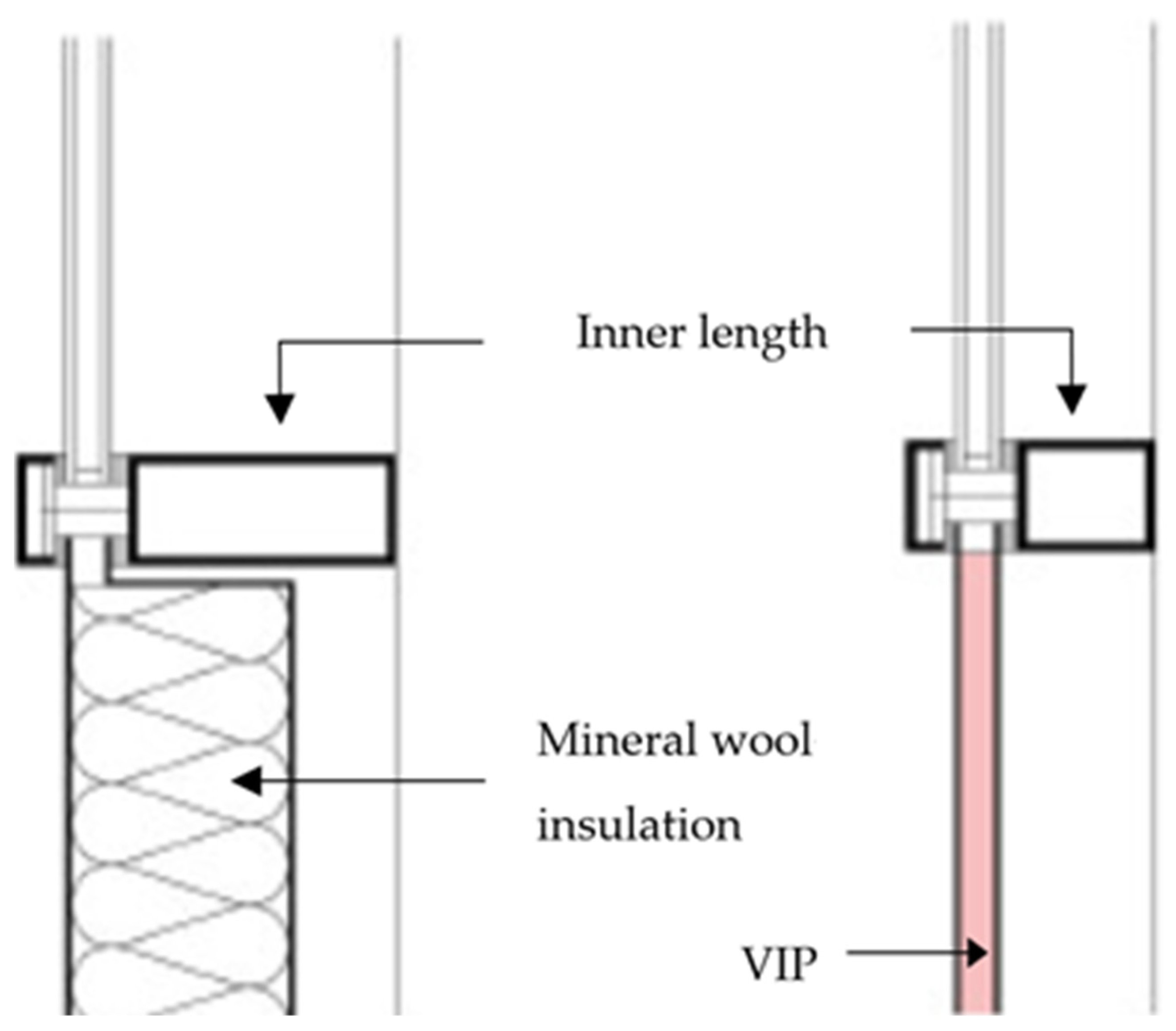
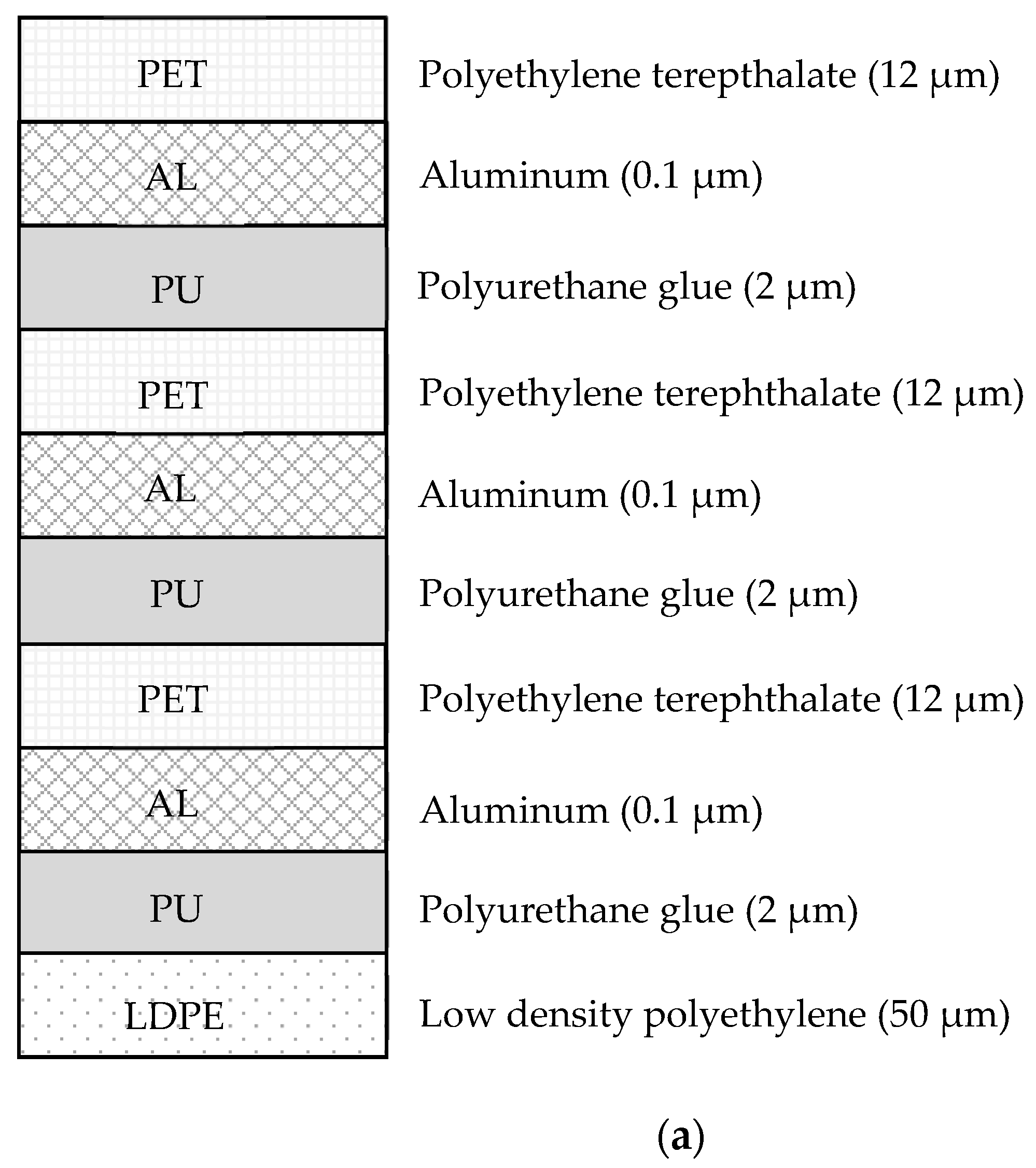
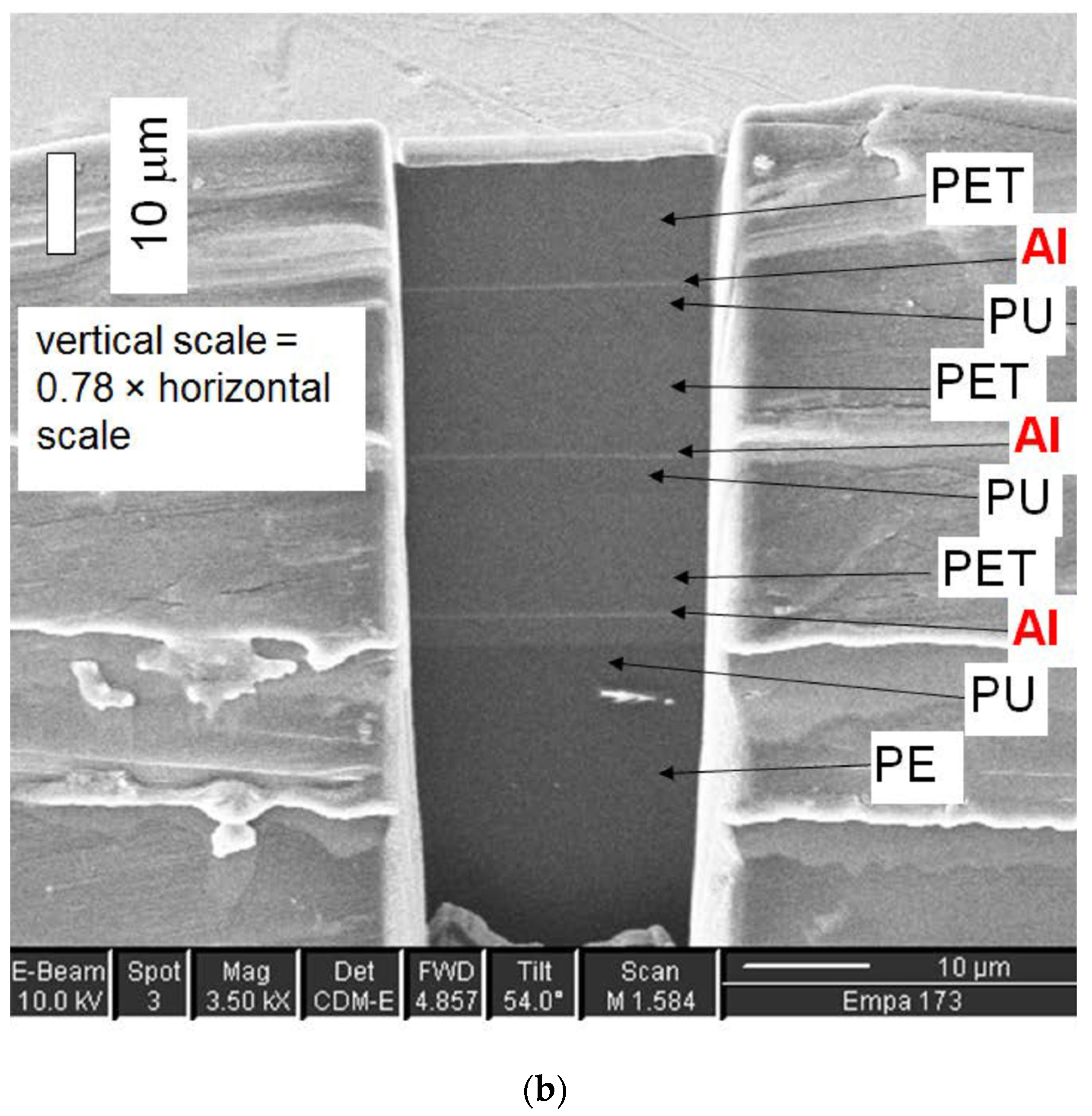


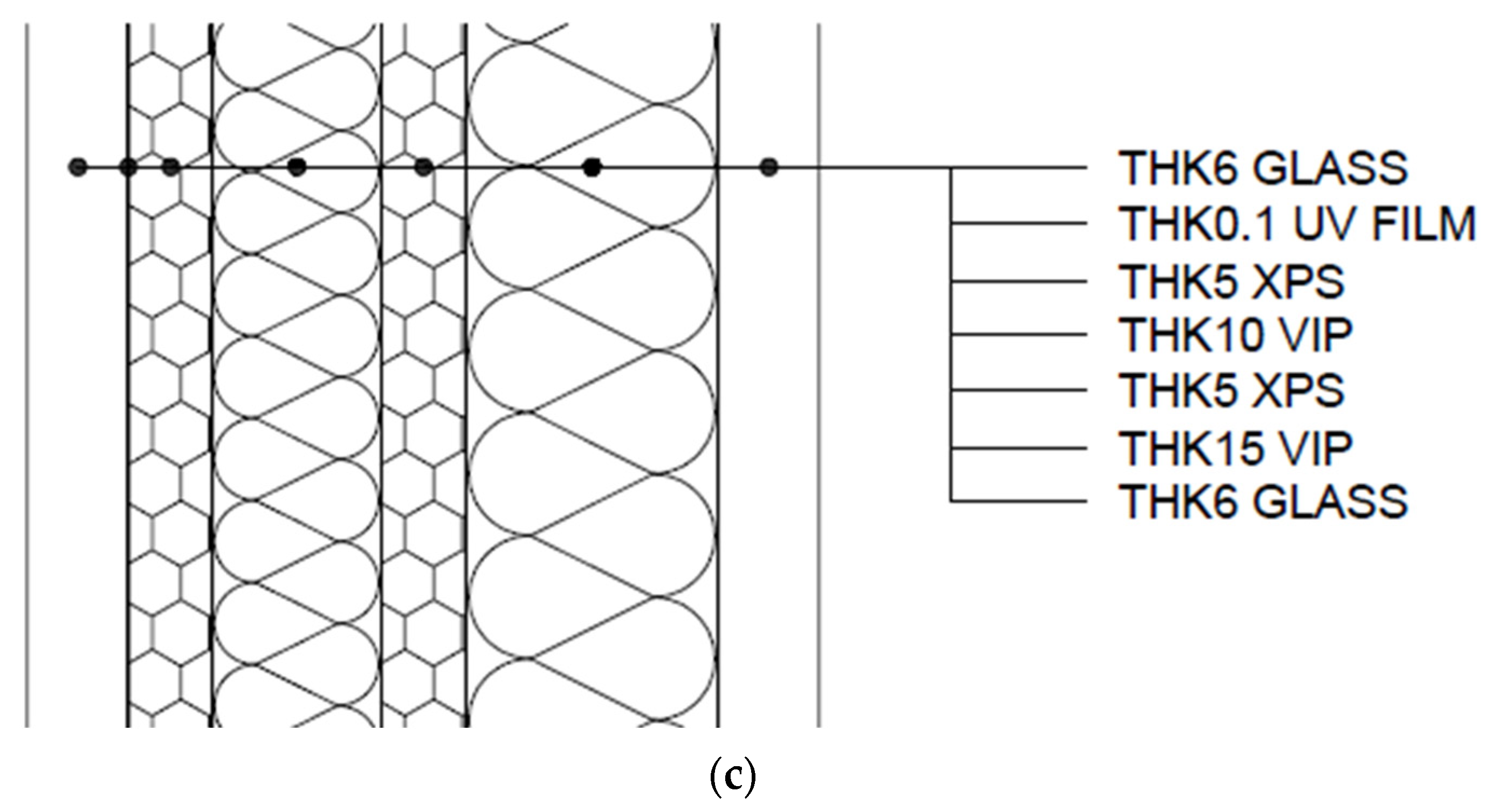
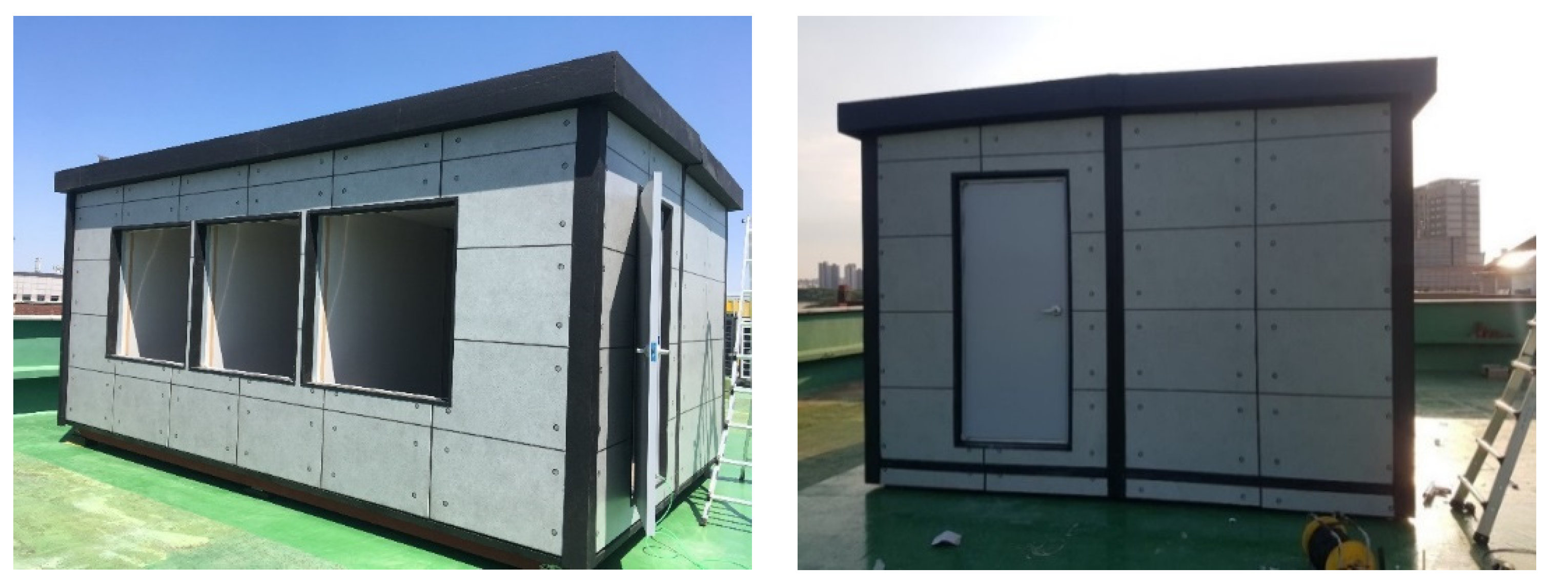

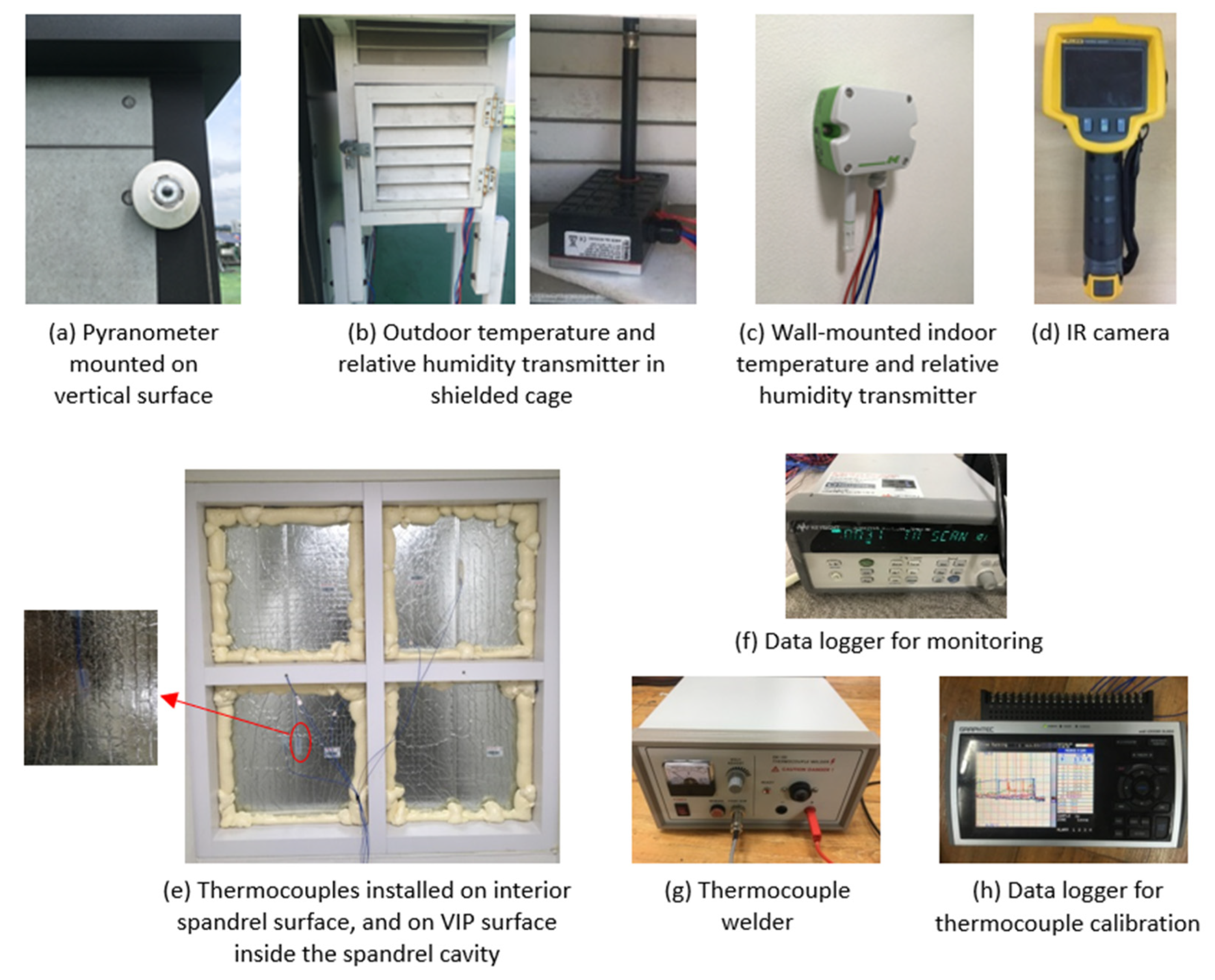


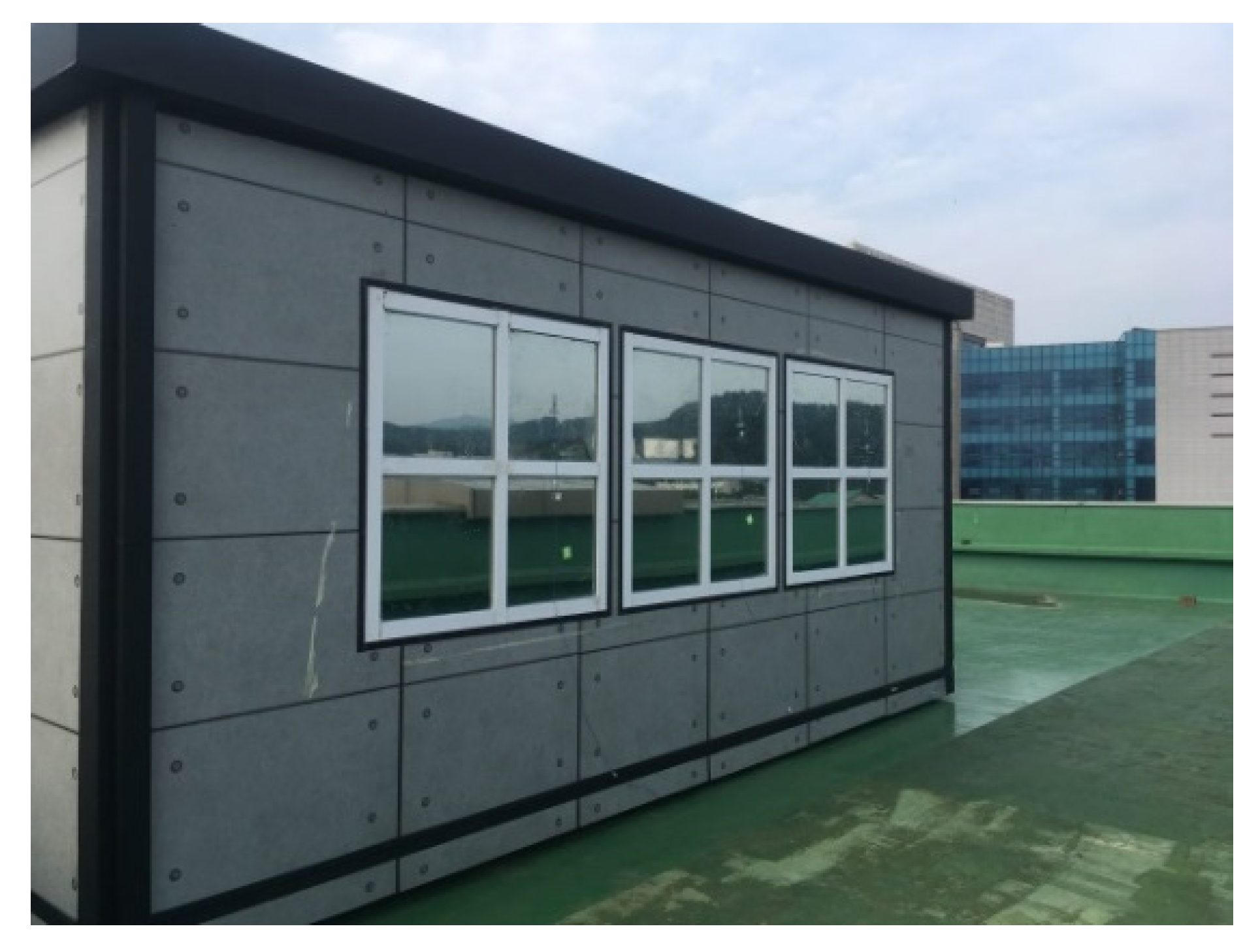
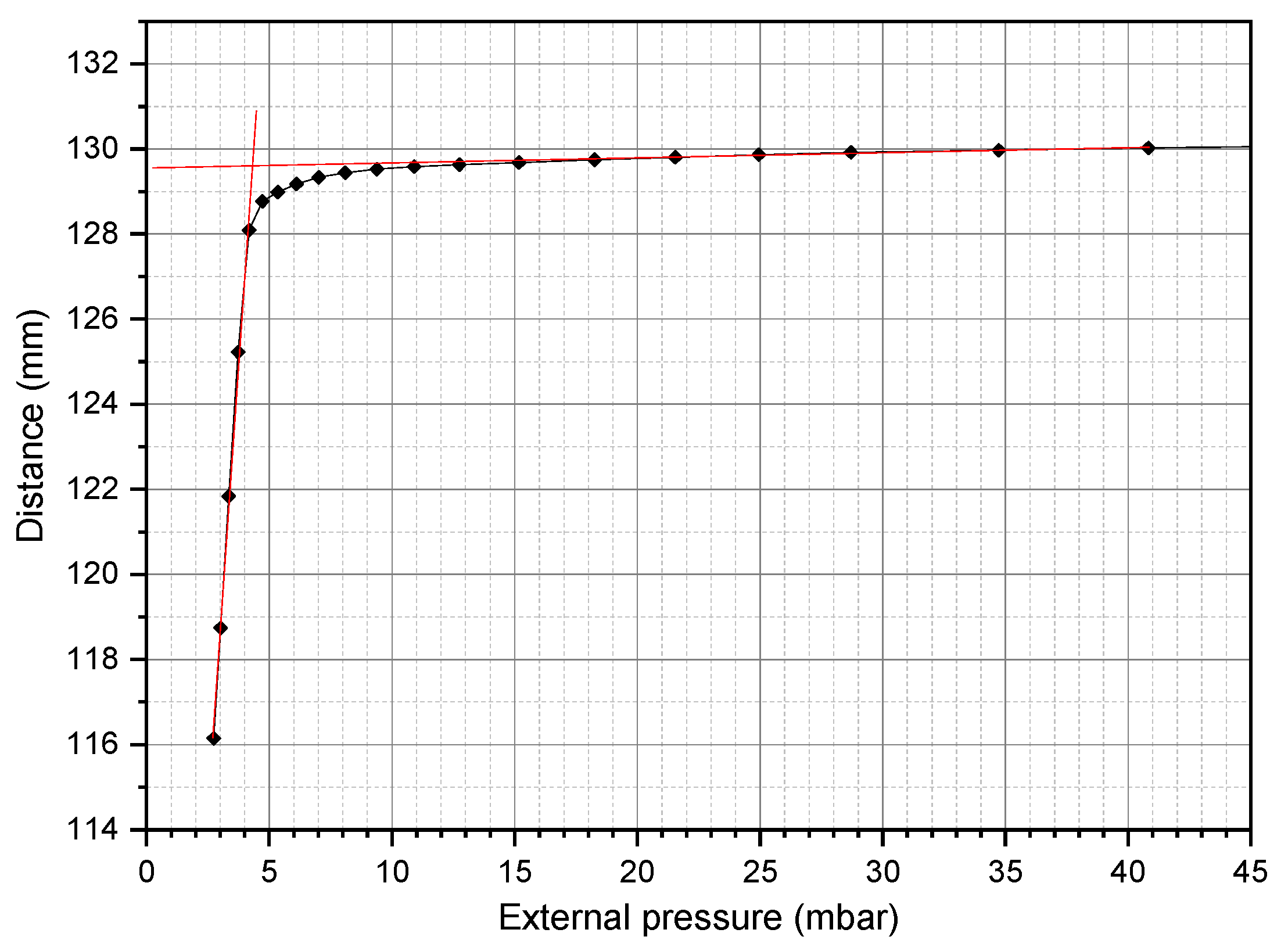
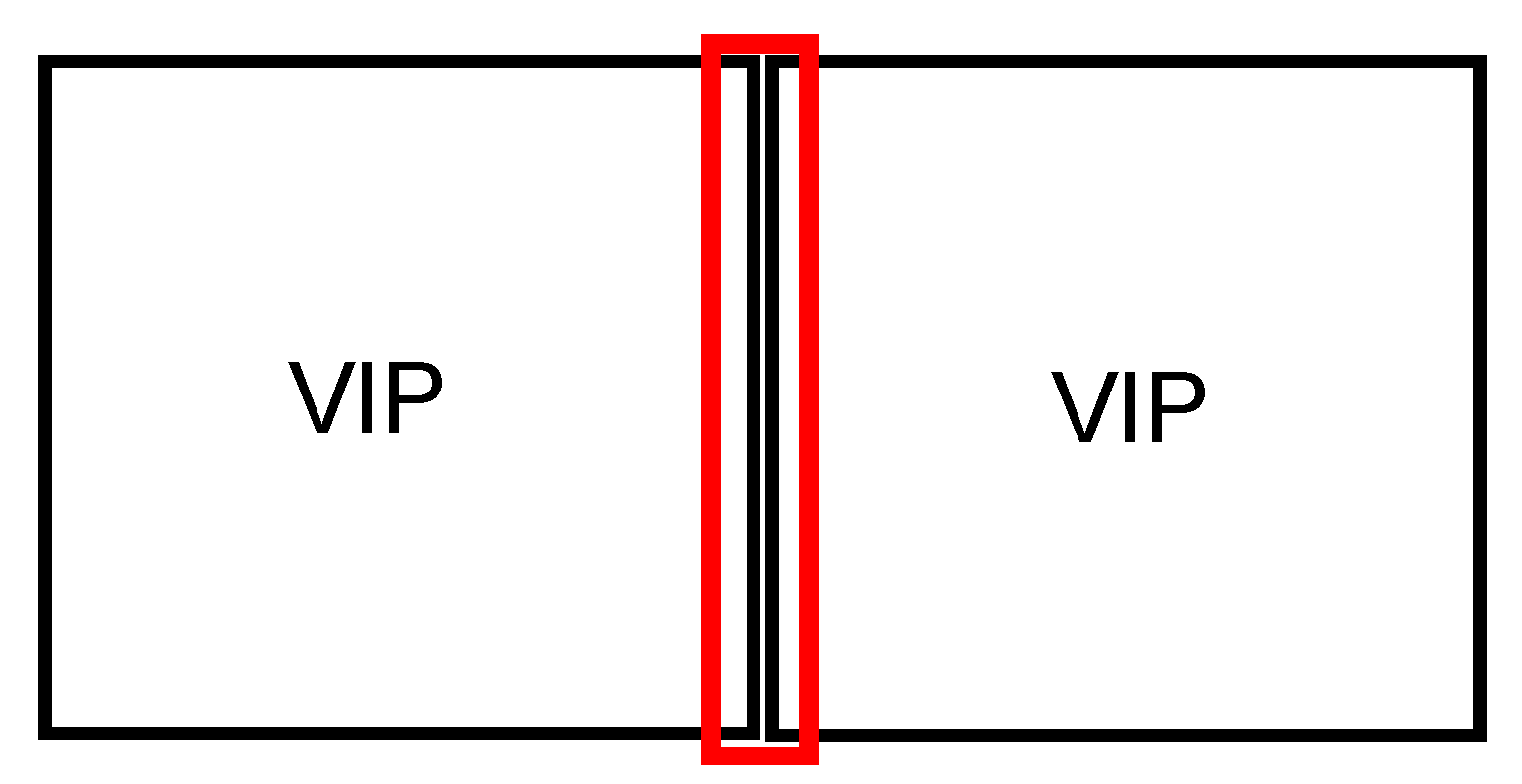
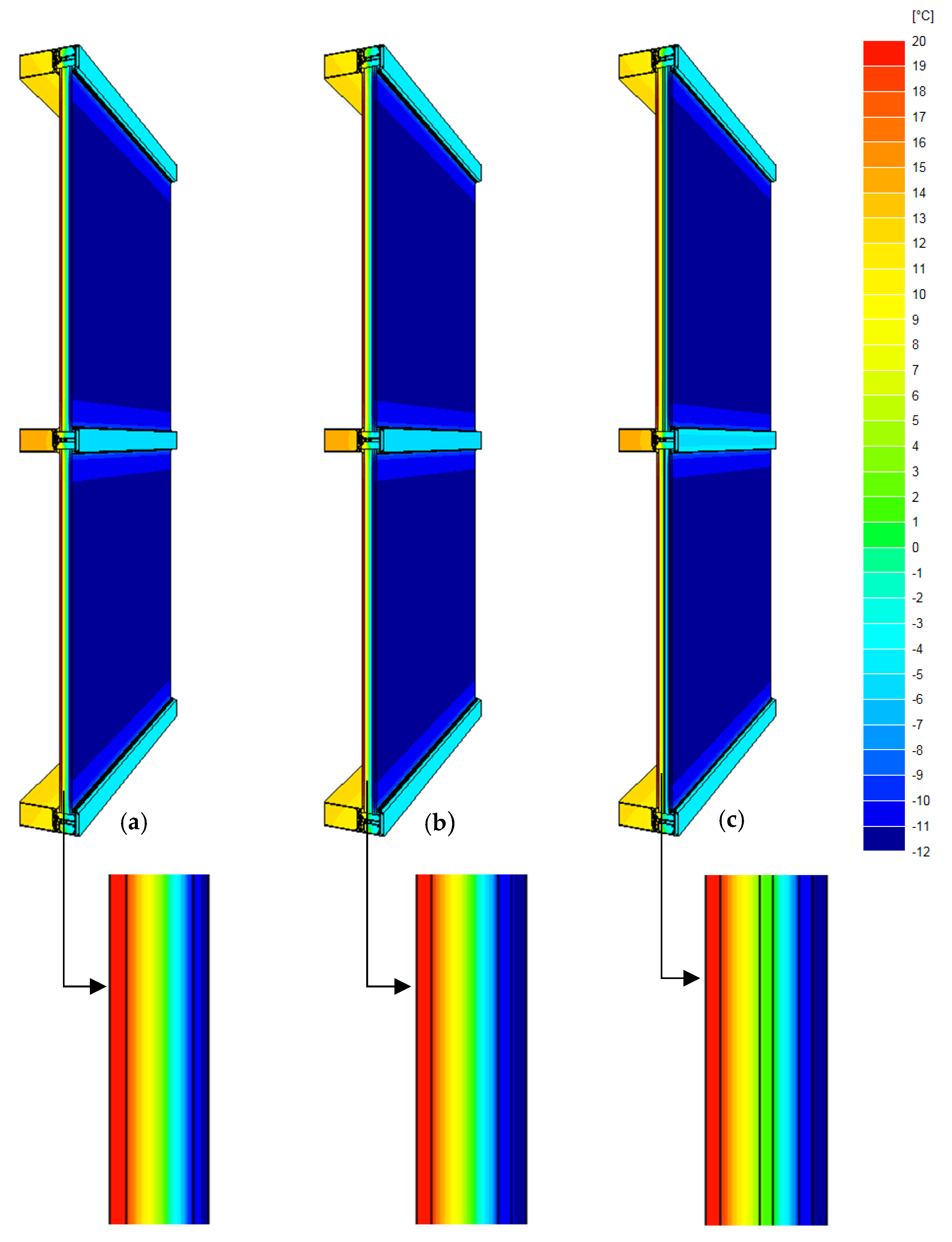
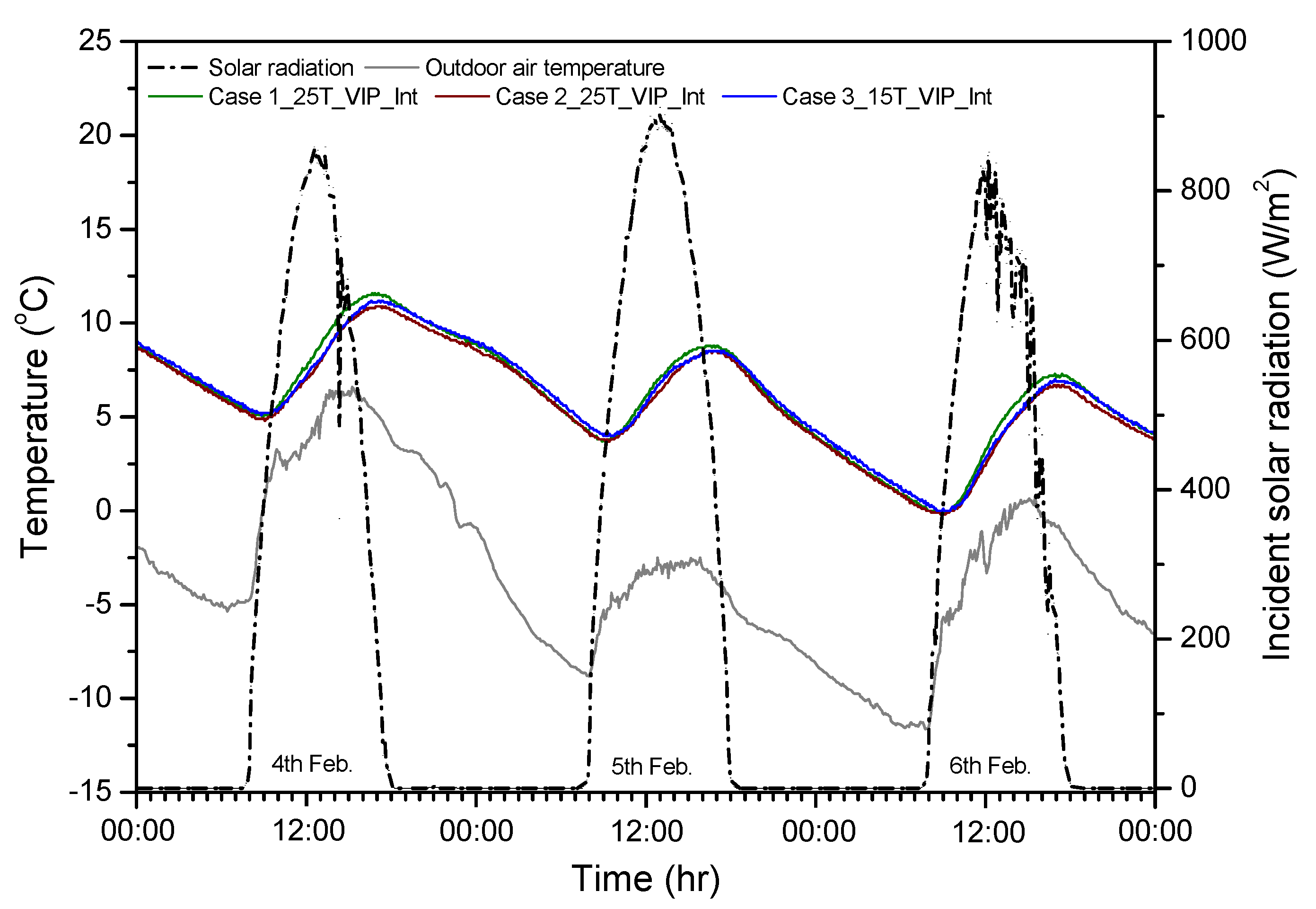

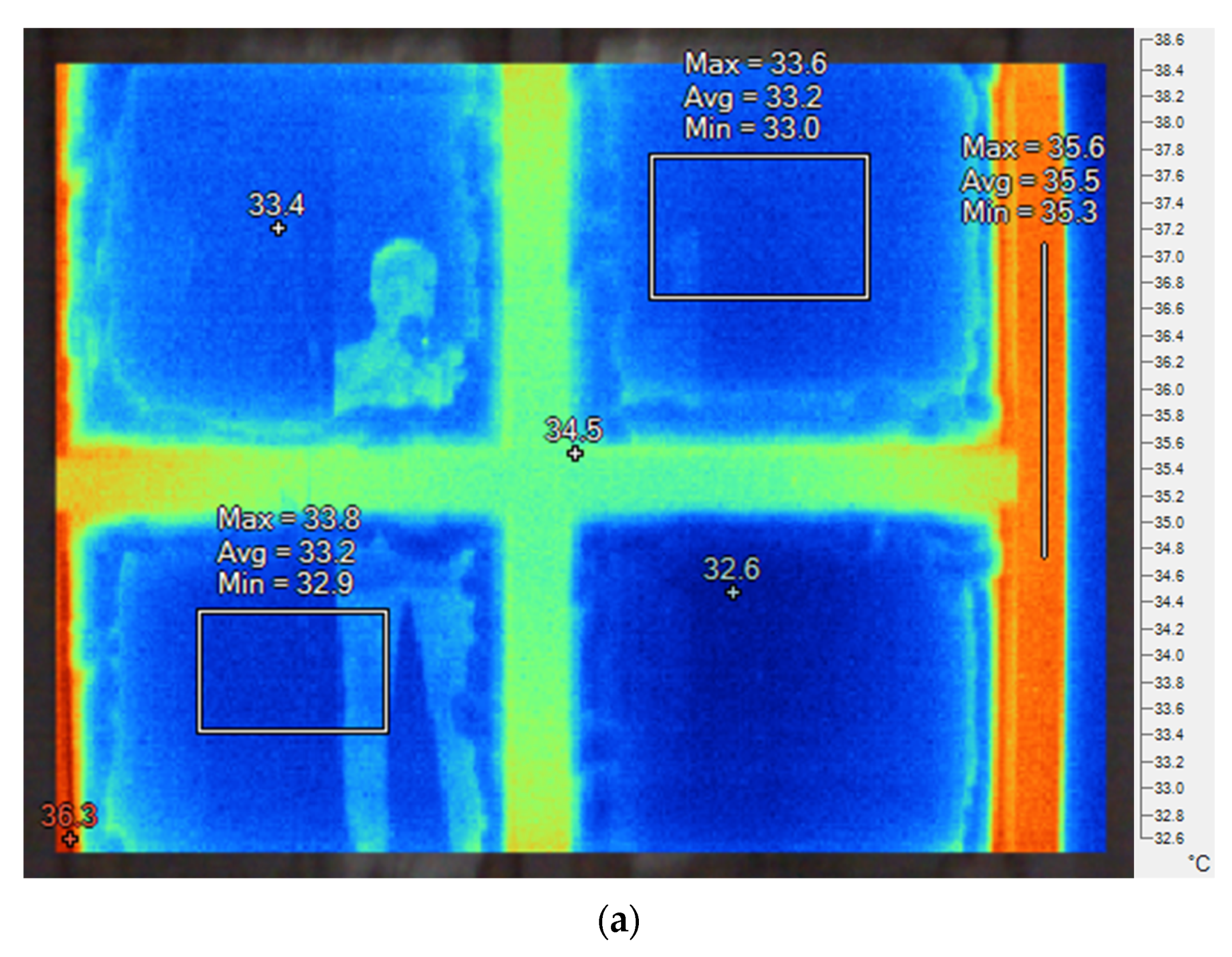

| Property | Test Method/Condition | Index |
|---|---|---|
| Total thickness | 92 (µm) | |
| Heat seal strength (HSS) | 165 °C, 4 kg/cm2, 2 s | >3.5 (N/mm) |
| Puncture resistance (PR) | FTMS 101C 2065 | 130 (N) |
| Moisture vapor transmission rate (MVTR) | ASTM F-1249-90, 38 °C 90% RH | <0.015 (gr/m2 day) |
| Gas Transmission Rate (GTR) | 22 °C 50% RH | <9 (cc (STP)/m2/year) |
| Material | Function | Thermal Conductivity, W/mK | Density, kg/m3 | Specific Heat, J/(kgK) | |
|---|---|---|---|---|---|
| Aluminum 1 | Frame | 160 | 2800 | 880 | |
| Glass 1 | Structural panel | 1 | 2500 | 750 | |
| Reinforced polyamide 1 | Primary seal | 0.3 | 1450 | 1600 | |
| Silicone 1 | Secondary seal | 0.35 | 1200 | 1000 | |
| EPDM 1 | Gasket | 0.25 | 1150 | 1000 | |
| Silica gel 1 | Desiccant | 0.13 | 720 | 1000 | |
| XPS 2 | Thermal breaker | 0.028 | 30 | 1000 | |
| VIP (10mm) 2,3 | Spandrel insulation | 0.0051 | 200 | 800 | |
| VIP (15mm) 2,3 | Spandrel insulation | 0.0051 | 200 | 800 | |
| VIP (25mm) 2,3 | Spandrel insulation | 0.0054 | 200 | 800 |
| Environment | Temperature (°C) | Surface Heat Transfer Coefficient (W/m2K) |
|---|---|---|
| Exterior | −11.3 | 23.25 |
| Interior | 20 | 9.09 |
| Property | Index |
|---|---|
| Solar heat gain coefficient (SHGC) | 0.23 |
| U value | 0.93 |
| Total solar energy rejected | 77% |
| Equipment Type (Model) | Specifications |
|---|---|
| K-Type thermocouple (KX-F-0.32) | Measurement range: −200 °C to 1372 °C Accuracy: ±0.50 (at −200 °C to −50 °C), ±0.25 (at −50 °C to 1372 °C) |
| Data logger for thermocouple calibration (Graphtec GL800) | Clock accuracy: ±0.002% (ambient temperature 23 °C) Operating environment: 0 °C to 45 °C/5% RH to 85% RH Measurement range and accuracy: ±(0.05% of reading + 2 °C) at −200 °C to −100 °C; ±(0.05% of reading + 1 °C) at −100 °C to 1370 °C. |
| Thermocouple welder (DK-50) | Input voltage: 220 V AC 1 A 60 Hz Output voltage: 24–48 VDC (20,000 uF) |
| Pyranometer (EKO MS-402) | Operating temperature: −40 °C to 80 °C Irradiance range: 0 to 4000 Wm−2 Wavelength range: 285–3000 nm Response time 95%: <8 s Sensitivity: 7 µV/Wm−2 Temperature response −10 °C to 40: ±1% Accuracy: first class pyranometer according to ISO 9060 |
| Indoor air temperature and relative humidity transmitter (EE160) | Operating temperature: −40 °C to 60 °C Measurement range: −40 °C to 60 °C/10% RH to 95% RH Accuracy at 20 °C: ±0.3 °C/±2.5% RH |
| Outdoor temperature and relative humidity transmitter (HygroFlex HF535) | Operating temperature: −40 °C to 60 °C Measurement range: −40 °C to 60 °C/0% RH to 100% RH Accuracy at 23 °C: ±0.1 °C/±0.8% RH |
| Data logger for monitoring (Yokogawa WE7241) | Measurement accuracy: ±(0.1% of reading + 1 °C), except −200 °C to 0 °C, ±(0.6% of reading + 1 °C) for thermocouple; ±(0.07% of reading + 40 mV) for pyranometer; ±(0.2% of reading + 3 mV) for air temperature/relative humidity transmitter |
| Infrared thermal camera (Fluke Ti32) | Operating temperature: −10 °C to 50 °C Infrared spectral band: 7.5 μm to 14 μm Measurement range: −20 °C to 600 °C Thermal sensitivity: ≤0.05 °C Accuracy: ±2 °C or ±2% |
| Sensor Locations | Case 1 | Case 2 | Case 3 |
|---|---|---|---|
| Interior surface (indoor) | 4 | 4 | 4 |
| Exterior surface (outdoor) | 2 | 2 | 2 |
| Surface of VIP (inside spandrel cavity) | 2 | 2 | 4 |
| Sample No. | Dimension, mm × mm × mm | Center-of-Panel Thermal Conductivity (λcop), W/mK | Inner Pressure (p), mbar |
|---|---|---|---|
| 1 | 600 × 600 × 25 | 0.00430 | 4.0 |
| 2 | 600 × 600 × 25 | 0.00428 | 4.0 |
| 3 | 600 × 600 × 25 | 0.00379 | 4.5 |
| 4 | 600 × 600 × 25 | 0.00392 | 4.0 |
| 5 | 600 × 600 × 25 | 0.00395 | 5.5 |
| 6 | 600 × 600 × 25 | 0.00382 | 5.0 |
| 7 | 600 × 600 × 25 | 0.00382 | 4.0 |
| 8 | 600 × 600 × 25 | 0.00386 | 4.0 |
| 9 | 600 × 600 × 25 | 0.00456 | 4.0 |
| 10 | 600 × 600 × 25 | 0.00438 | 4.0 |
| 11 | 600 × 600 × 15 | 0.00397 | 5.0 |
| 12 | 600 × 600 × 15 | 0.00396 | 5.5 |
| 13 | 600 × 600 × 15 | 0.00396 | 5.5 |
| 14 | 600 × 600 × 15 | 0.00400 | 5.0 |
| 15 | 600 × 600 × 15 | 0.00402 | 6.0 |
| 16 | 600 × 600 × 15 | 0.00405 | 5.0 |
| 17 | 600 × 600 × 10 | 0.00420 | 5.5 |
| 18 | 600 × 600 × 10 | 0.00412 | 4.5 |
| 19 | 600 × 600 × 10 | 0.00426 | 6.0 |
| 20 | 600 × 600 × 10 | 0.00424 | 7.0 |
| 21 | 600 × 600 × 10 | 0.00426 | 6.0 |
| 22 | 600 × 600 × 10 | 0.00437 | 6.5 |
| Description | 25 mm VIP | 15 mm VIP | 10 mm VIP |
|---|---|---|---|
| Mean center-of-panel thermal conductivity, W/mK | 0.0041 | 0.0040 | 0.0042 |
| Linear thermal transmittance, W/mK | 0.008 | 0.011 | 0.013 |
| Effective thermal conductivity (including thermal bridge), W/mK | 0.0054 | 0.0051 | 0.0051 |
| Description | Case 1 | Case 2 | Case 3 |
|---|---|---|---|
| Linear thermal transmittance, ψ (W/mK) | 0.23 | 0.22 | 0.19 |
| 1-D thermal transmittance, U1-D (W/m2K) | 0.21 | 0.20 | 0.18 |
| Effective thermal transmittance, Ueff (W/m2K) | 0.87 | 0.85 | 0.84 |
| Lowest indoor surface temperature | 13.8 °C | 14.3 °C | 14.3 °C |
| Lowest temperature factor | 0.57 | 0.66 | 0.67 |
| Description | Outdoor Air Temperature (°C) | Solar Radiation (W/m2) | VIP Spandrel–Al Frame Thermal Bridge Junction Interior Surface Temperature (°C) | |||
|---|---|---|---|---|---|---|
| Case 1 | Case 2 | Case 3 | ||||
| Day | Max | −2.5 | 911.55 | 11.2 | 9.6 | 9.2 |
| Min | −8.8 | 1.43 | 1.7 | 2.6 | 3.2 | |
| Avg | −4.4 | 581.48 | 6.8 | 6.3 | 6.1 | |
| SD | 1.92 | 285.25 | 3.71 | 2.79 | 2.32 | |
| Night | Max | −5.8 | 7.5 | 7.2 | 7.5 | |
| Min | −10.9 | −0.5 | 0.2 | 0.8 | ||
| Avg | −8.2 | 2.4 | 3.1 | 3.6 | ||
| SD | 1.55 | 2.14 | 1.89 | 1.86 | ||
| Description | Outdoor Air Temperature (°C) | Solar Radiation (W/m2) | VIP Interior Surface Temp. (°C) | Spandrel Interior Surface Temp. (°C) | |||||
|---|---|---|---|---|---|---|---|---|---|
| Case 1 | Case 2 | Case 3 | Case 1 | Case 2 | Case 3 | ||||
| Day | Max | −2.5 | 911.55 | 8.7 | 8.5 | 8.5 | 8.9 | 8.4 | 8.6 |
| Min | −8.8 | 1.43 | 3.7 | 3.7. | 4 | 3.9 | 3.9 | 4.2 | |
| Avg | −4.4 | 581.48 | 6.2 | 5.89 | 6.09 | 6.3 | 5.9 | 6.1 | |
| SD | 1.92 | 285.25 | 1.90 | 1.75 | 1.68 | 1.82 | 1.64 | 1.58 | |
| Night | Max | −5.8 | 7.4 | 7.2 | 7.6 | 7.5 | 7.3 | 7.7 | |
| Min | −10.9 | 1.4 | 1.3 | 1.6 | 1.5 | 1.4 | 1.8 | ||
| Avg | −8.2 | 4.0 | 3.9 | 4.3 | 4.2 | 4.1 | 4.5 | ||
| SD | 1.55 | 1.72 | 1.69 | 1.69 | 1.68 | 1.67 | 1.66 | ||
| Description | Outdoor Air Temperature (°C) | Solar Radiation (W/m2) | VIP Exterior Surface Temp. (°C) | Spandrel Exterior Surface Temp. (°C) | |||||
|---|---|---|---|---|---|---|---|---|---|
| Case 1 | Case 2 | Case 3 | Case 1 | Case 2 | Case 3 | ||||
| Day | Max | −2.5 | 911.55 | 37 | 37.6 | 35.9 | 31.3 | 32.7 | 31.8 |
| Min | −8.8 | 1.43 | −11 | −10.7 | −10.5 | −11.3 | −11.2 | −11.2 | |
| Avg | −4.4 | 581.48 | 20.8 | 20.9 | 19.9 | 16.8 | 17.5 | 17 | |
| SD | 1.92 | 285.25 | 14.75 | 15.54 | 14.61 | 12.83 | 13.22 | 12.85 | |
| Night | Max | −5.8 | −7.5 | −4.8 | −6.3 | −8 | −8 | −7.9 | |
| Min | −10.9 | −13.4 | −13 | −12.9 | −13.8 | −13.8 | −13.6 | ||
| Avg | −8.2 | −10.6 | −10 | −10 | −10.9 | −10.9 | −10.7 | ||
| SD | 1.55 | 1.73 | 1.95 | 1.81 | 1.72 | 1.72 | 1.74 | ||
| Description | Case 1 | Case 2 | Case 3 |
|---|---|---|---|
| Experimental (calculated average), W | 3.51 | 3.42 | 3.23 |
| Numerical (steady state simulation), W | 3.90 | 3.74 | 3.60 |
Publisher’s Note: MDPI stays neutral with regard to jurisdictional claims in published maps and institutional affiliations. |
© 2022 by the authors. Licensee MDPI, Basel, Switzerland. This article is an open access article distributed under the terms and conditions of the Creative Commons Attribution (CC BY) license (https://creativecommons.org/licenses/by/4.0/).
Share and Cite
Boafo, F.E.; Kim, J.-H.; Ahn, J.-G.; Kim, S.-M.; Kim, J.-T. In Situ Experimental Investigation of Slim Curtain Wall Spandrel Integrated with Vacuum Insulation Panel. Buildings 2022, 12, 199. https://doi.org/10.3390/buildings12020199
Boafo FE, Kim J-H, Ahn J-G, Kim S-M, Kim J-T. In Situ Experimental Investigation of Slim Curtain Wall Spandrel Integrated with Vacuum Insulation Panel. Buildings. 2022; 12(2):199. https://doi.org/10.3390/buildings12020199
Chicago/Turabian StyleBoafo, Fred Edmond, Jin-Hee Kim, Jong-Gwon Ahn, Sang-Myung Kim, and Jun-Tae Kim. 2022. "In Situ Experimental Investigation of Slim Curtain Wall Spandrel Integrated with Vacuum Insulation Panel" Buildings 12, no. 2: 199. https://doi.org/10.3390/buildings12020199
APA StyleBoafo, F. E., Kim, J.-H., Ahn, J.-G., Kim, S.-M., & Kim, J.-T. (2022). In Situ Experimental Investigation of Slim Curtain Wall Spandrel Integrated with Vacuum Insulation Panel. Buildings, 12(2), 199. https://doi.org/10.3390/buildings12020199








